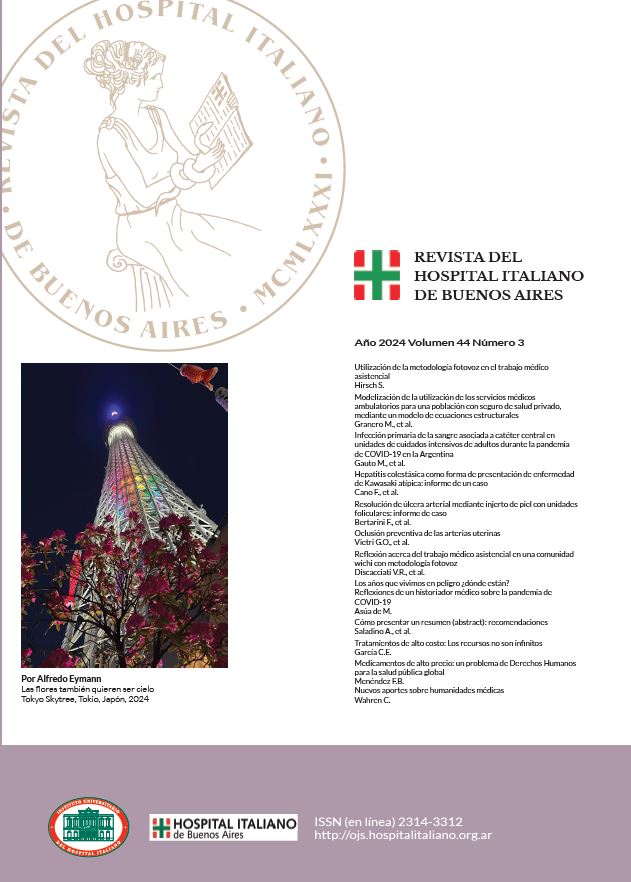Resolución de Úlcera Arterial mediante Injerto de Piel con Unidades Foliculares: Reporte de Caso
Contenido principal del artículo
Resumen
Las úlceras crónicas impactan significativamente en la calidad de vida del paciente y generan elevados costos para el sistema de salud. Un enfoque terapéutico integral, considerando el diagnóstico y las características de la herida, es esencial para cada fase de cicatrización. Durante la epitelización se recomienda el uso de técnicas con injertos para acelerar la reparación, mejorar la calidad del tejido cicatrizal y abordar el dolor. La técnica de autoinjerto por punch de unidades foliculares, obtenidas del cuero cabelludo, se presenta como una estrategia aceptada para la reparación de heridas crónicas. Se ilustra el caso de un paciente de 79 años con múltiples comorbilidades y con una úlcera arterial de importante dimensión donde, luego de controlar la patología de base y lograr un lecho óptimo, el autoinjerto con unidades foliculares, derivó en la completa cicatrización al cabo de 4 meses.
Downloads
Detalles del artículo
Sección

Esta obra está bajo una licencia internacional Creative Commons Atribución-NoComercial-CompartirIgual 4.0.
Cómo citar
Referencias
Baquerizo Nole KL, Kirsner RS. Hair follicles and their potential in wound healing. Exp Dermatol. 2015;24(2):95-96. https://doi.org/10.1111/exd.12607. DOI: https://doi.org/10.1111/exd.12607
Budamakuntla L, Loganathan E, Sarvajnamurthy SA, et al. Follicular unit grafting in chronic nonhealing leg ulcers: a clinical study. J Cutan Aesthet Surg. 2017;10(4):200-206. https://doi.org/10.4103/JCAS.JCAS_38_17. DOI: https://doi.org/10.4103/JCAS.JCAS_38_17
Martínez Martínez ML, Escario Travesedo E, Jiménez Acosta F. Hair-follicle transplant into chronic ulcers: a new graft concept. Actas Dermosifiliogr. 2017;108(6):524-531. https://doi.org/10.1016/j.ad.2017.02.013. DOI: https://doi.org/10.1016/j.adengl.2017.05.016
Agale SV. Chronic leg ulcers: epidemiology, aetiopathogenesis, and management. Ulcers. 2013;2013:413604. http://dx.doi.org/10.1155/2013/413604. DOI: https://doi.org/10.1155/2013/413604
Crawford BS. An unusual skin donor site. Br J Plast Surg. 1964;17:311-333. https://doi.org/10.1016/s0007-1226(64)80049-7. DOI: https://doi.org/10.1016/S0007-1226(64)80049-7
Cheng CC, Tsutsui K, Taguchi T, et al. Hair follicle epidermal stem cells define a niche for tactile sensation. Elife. 2018;7:e38883. https://doi.org/10.7554/eLife.38883. DOI: https://doi.org/10.7554/eLife.38883
Plikus MV, Gay DL, Treffeisen E, et al. Epithelial stem cells and implications for wound repair. Semin Cell Dev Biol. 2012;23(9):946-953. https://doi.org/10.1016/j.semcdb.2012.10.001. DOI: https://doi.org/10.1016/j.semcdb.2012.10.001
Liu JQ, Zhao KB, Feng ZH, et al. Hair follicle units promote re-epithelialization in chronic cutaneous wounds: a clinical case series study. Exp Ther Med. 2015;10(1):25-30. https://doi.org/10.3892/etm.2015.2465. DOI: https://doi.org/10.3892/etm.2015.2465
Martinot V, Mitchell V, Fevrier P, et al. Comparative study of split thickness skin grafts taken from the scalp and thigh in children. Burns. 1994;20(2):146-150. https://doi.org/10.1016/s0305-4179(06)80012-4. DOI: https://doi.org/10.1016/S0305-4179(06)80012-4
Jiménez F, Garde C, Poblet E, et al. A pilot clinical study of hair grafting in chronic leg ulcers. Wound Repair Regen. 2012;20(6):806-814. https://doi.org/10.1111/j.1524-475X.2012.00846.x. DOI: https://doi.org/10.1111/j.1524-475X.2012.00846.x
Martínez ML, Escario E, Poblet E, et al. Hair follicle-containing punch grafts accelerate chronic ulcer healing: a randomized controlled trial. J Am Acad Dermatol. 2016;75(5):1007-1014. https://doi.org/10.1016/j.jaad.2016.02.1161. DOI: https://doi.org/10.1016/j.jaad.2016.02.1161
Jimenez F, Poblet E, Izeta A. Reflections on how wound healing-promoting effects of the hair follicle can be translated into clinical practice. Exp Dermatol. 2015;24(2):91-94. https://doi.org/10.1111/exd.12521. DOI: https://doi.org/10.1111/exd.12521
Belatti A, Bertarini F, Pombo V, et al. Follicular unit grafting in chronic ulcers: a valuable technique for integrated management. An Bras Dermatol. 2024;99(4):568-577. https://doi.org/10.1016/j.abd.2023.08.012. DOI: https://doi.org/10.1016/j.abd.2023.08.012
Schultz GS, Sibbald RG, Falanga V, et al. Wound bed preparation: a systematic approach to wound management. Wound Repair Regen. 2003;11(Suppl 1):S1-S28. https://doi.org/10.1046/j.1524-475x.11.s2.1.x. DOI: https://doi.org/10.1046/j.1524-475X.11.s2.1.x
Leaper DJ, Schultz G, Carville K, et al. Extending the TIME concept: what have we learned in the past 10 years?(*). Int Wound J. 2012;9(Suppl 2):1-19. https://doi.org/10.1111/j.1742-481X.2012.01097.x. DOI: https://doi.org/10.1111/j.1742-481X.2012.01097.x
Moore Z, Dowsett C, Smith G, et al. TIME CDST: an updated tool to address the current challenges in wound care. J Wound Care. 2019;28(3):154-161. https://doi.org/10.12968/jowc.2019.28.3.154. DOI: https://doi.org/10.12968/jowc.2019.28.3.154
Harries RL, Bosanquet DC, Harding KG. Wound bed preparation: TIME for an update. Int Wound J. 2016;13(Suppl 3):8-14. https://doi.org/10.1111/iwj.12662. DOI: https://doi.org/10.1111/iwj.12662

